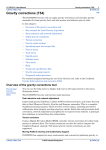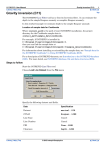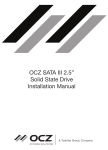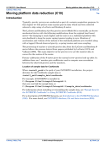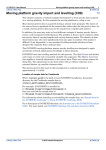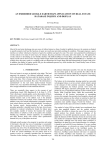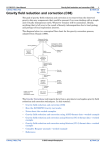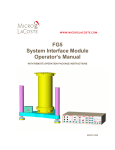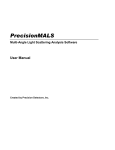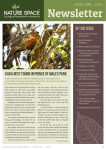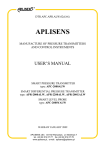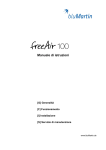Download Gravity corrections available (T54a)
Transcript
INTREPID User Manual Library | Contents | Top Gravity corrections available (T54a) 1 | Back | Gravity corrections available (T54a) Top The INTREPID Gravity tool can calculate individual gravity corrections or gravity anomalies for a gravity point dataset. It creates new fields to store these values. Use the reverse anomaly corrections to recreate an obsgrav field for a dataset that has only FreeAir or Bouguer fields. Note: You automatically create the free air anomaly and the simple Bouguer anomaly when you reduce loop data to final. To perform these corrections 1 Check that you have specified the appropriate datum and density settings (see "Gravity tool settings (T54b)" for details). 2 Choose Gravity Transforms from the Process menu. Specify the gravity point dataset for correction. Select the correction that you require. Choose Finish. 3 Library | Contents | Top INTREPID prompts you for the required input and output fields (see below for details). INTREPID will not prompt for a field name if there is a corresponding valid alias. | Back | INTREPID User Manual Library | Contents | Top 4 Gravity corrections available (T54a) 2 | Back | INTREPID displays the current settings (if any) to use in the calculation. If you wish to change the settings, choose No to cancel gravity correction and then modify the gravity settings as required (see "Gravity tool settings (T54b)" for details). • To continue, choose Yes. • To cancel, choose No. INTREPID creates the new field in the gravity point dataset and appends a processing report to the current processing report file. If you have not specified a report file name during the current INTREPID session, it is named processing.rpt by default. The processing report does not display automatically, but you can locate the file in the current directory. You can • View the processing report using a text editor. • Use the Spreadsheet Editor to view the new field data. • Use the Visualisation tool to view the data graphically. Tip: Assign the elevation field to point colour and the observed gravity or an anomaly field to point size. See Steps 2 and 3 of the complete Bouguer worked example in "Gravity field reduction and correction (C08)" for details. Theoretical gravity The theoretical gravity is a mathematical model of the earth's gravity field. It takes into account that the earth is an ellipsoid rather than a sphere. Each ellipsoid model has a corresponding gravity datum. INTREPID uses the latitude and datum to create a new theoretical gravity field. Input field Latitude Output field Theoretical gravity (theograv) INTREPID also automatically subtracts the theoretical gravity as one of the steps when it calculates the free air anomaly and simple Bouguer anomaly. Library | Contents | Top | Back | INTREPID User Manual Library | Contents | Top Gravity corrections available (T54a) 3 | Back | Sample processing report Calculating theoretical gravity for all data base points -------------------------------------------------------- Latitude field : D:/Intrepid/cookbook/gravity/datasets/Survey9705/ Latitude Calculated gravity field: D:/Intrepid/cookbook/gravity/datasets/Survey9705/ theograv Gravity datum : IGSN71 Gravity units : Milligals To convert data reduced to a different ellipsoid: You may want to merge two datasets that were reduced to different ellipsoids. If the datasets do not contain an observed gravity field you can use this option to revert to observed gravity for one of the datasets. You can then reduce the observed gravity to the required ellipsoid as usual. 1 From the Settings menu, select the datum that was used for the original reduction. Choose Theoretical Gravity to calculate the theoretical gravity that was subtracted from the observed gravity using this ellipsoid. 2 Use the spreadsheet editor to reapply (add) the theoretical gravity to the corrected gravity field to recreate the observed gravity field obsgrav .See Step 2 of the complete Bouguer worked example in "Gravity field reduction and correction (C08)" for an example of using the Spreadsheet tool. 3 Select your preferred datum from the Settings menu (for example WGS84). Calculate the theoretical gravity using this preferred datum. 4 Use the spreadsheet editor to subtract the revised theoretical gravity from the observed gravity. Library | Contents | Top | Back | INTREPID User Manual Library | Contents | Top Gravity corrections available (T54a) 4 | Back | Free air anomaly The free air correction compensates the observed gravity for the fact that it was measured at a given height above (or below) the datum. It assumes, however, that there is nothing but air between sea level and the observation point. INTREPID calculates the free air correction from the elevation and observed gravity fields and the terrain type. The free air anomaly is calculated as follows: FreeAir = obsgrav - theoretical gravity - free air correction Input field obsgrav, Latitude, Elevation Output field FreeAir Free air correction formula Here is the formula for free air correction using the full formula expressed as a vertical gradient. For IGSN71(GRS67) the formula is as follows (Robbins, 1981) and (Fils, Butt, Hawke, 1998) (See "Free air references" in Gravity references (R32)): δgh /δh = –2go/a[1 + f + m + (–3f + (5m)/2)sin2φ] + (6go/a2)*h where go = equatorial gravity on the ellipsoid f = flattening coefficient = 1/298.25 a = semi-major axis radius of the ellipsoid = 6378160 m m = centrifugal force at equator go = 0.0034498014 φ = latitude h = height above ellipsoid = 9780318.456 µms–2 This can be expressed as: Free Air correction = (3.08768 – 0.00440 sin2φ )*h – 0.000001442*h2 µms–2 per metre; Library | Contents | Top | Back | INTREPID User Manual Library | Contents | Top Gravity corrections available (T54a) 5 | Back | Sample processing report Calculating Free Air Anomaly ---------------------------- Observed gravity field obsgrav Latitude field Station Elevation field Meter Elevation field Output free air field zzzz Gravity datum Terrain type Gravity units : D:/Intrepid/cookbook/gravity/datasets/Survey9705/ : : : : Survey9705/Latitude Survey9705/Elevation NO METER ELEVATION DATA BEING USED D:/Intrepid/cookbook/gravity/datasets/Survey9705/ : IGSN71 : land : Milligals Reverse free air anomaly Use this correction when your data contains a free air anomaly field but no observed gravity field. INTREPID adds the free air correction and the theoretical gravity to the free air anomaly field to recreate the observed gravity field. obsgrav = FreeAir + free air correction + theoretical gravity Input field FreeAir, Latitude, Elevation, Output field obsgrav Sample processing report Reversing Free Air anomaly to observed gravity. ---------------------------------------------- Free air gravity field FreeAir Latitude field Station Elevation field Meter Elevation field Output gravity field obsgrav Gravity datum Terrain type Gravity units Library | Contents | Top : D:/Intrepid/cookbook/gravity/datasets/Survey9705/ : : : : Survey9705/Latitude Survey9705/Elevation NO METER ELEVATION DATA BEING USED D:/Intrepid/cookbook/gravity/datasets/Survey9705/ : IGSN71 : land : Milligals | Back | INTREPID User Manual Library | Contents | Top Gravity corrections available (T54a) 6 | Back | Simple Bouguer anomaly The simple Bouguer correction replaces the "air" in the Free Air anomaly with rock. INTREPID uses the observed gravity field and the specified density and datum settings to calculate the simple Bouguer correction. The simple Bouguer anomaly is calculated as follows: Bouguer = obsgrav - theoretical gravity - free air correction - simple Bouguer correction Input field obsgrav, Latitude, Elevation Output field FreeAir You can experiment with different density settings to create a series of simple Bouguer anomaly fields; for example Bouguer267, Bouguer250, Bouguer200 . Sample processing report Calculating Simple Bouguer Anomaly ---------------------------------- Observed gravity field : D:/Intrepid/cookbook/gravity/import_data/ Survey9533_0710/Bouguer Latitude field : D:/Intrepid/cookbook/gravity/import_data/Survey9533_0710/ Latitude Station Elevation field : D:/Intrepid/cookbook/gravity/import_data/ Survey9533_0710/Elevation Meter Elevation field : NO METER ELEVATION DATA BEING USED Bouguer anomaly field : D:/Intrepid/cookbook/gravity/import_data/ Survey9533_0710/Bouguer2 Gravity datum : IGSN71 Terrain type : land Density : 2.670 Gravity units : Milligals Library | Contents | Top | Back | INTREPID User Manual Library | Contents | Top Gravity corrections available (T54a) 7 | Back | Reverse simple Bouguer anomaly INTREPID calculates the observed gravity from the simple Bouguer gravity anomaly field. obsgrav = Bouguer + simple Bouguer correction + free air correction + theoretical gravity Input field Bouguer, Latitude, Elevation Output field obsgrav This is useful if you have data that is missing an observed gravity field and want to process it using different settings or corrections. Sample processing report Calculating Simple Bouguer Anomaly Reversing Simple Bouguer anomaly to observed gravity ---------------------------------------------------- Bouguer anomaly field Bouguer Latitude field Station Elevation field Meter Elevation field Output gravity field obsgrav Gravity datum Terrain type Density Gravity units : D:/Intrepid/cookbook/gravity/datasets/Survey9705/ : : : : Survey9705/Latitude Survey9705/Elevation NO METER ELEVATION DATA BEING USED D:/Intrepid/cookbook/gravity/datasets/Survey9705/ : : : : IGSN71 land 2.670 Milligals Eötvös gravity correction Use this correction for marine and airborne survey data before reducing loop data to final. The correction compensates for measurements taken from a moving platform. It calculates the difference between the angular velocity of the observation platform and that of the rotating earth. Input field Latitude, line bearing and craft velocity fields Output field Eotvos Tip: INTREPID currently uses the simple velocity correction. We are developing a more complex method using cross correlation. Library | Contents | Top | Back | INTREPID User Manual Library | Contents | Top Gravity corrections available (T54a) 8 | Back | Sample processing report Calculating Eotvos gravity for all data base points --------------------------------------------------- Latitude field : Latitude Line bearing field : bearing Craft velocity field : velocity Calculated Eotvos field: Eotvos Gravity units : D:/Intrepid/cookbook/gravity/datasets/Survey9705/ D:/Intrepid/cookbook/gravity/datasets/Survey9705/ D:/Intrepid/cookbook/gravity/datasets/Survey9705/ D:/Intrepid/cookbook/gravity/datasets/Survey9705/ Milligals Applying the correction Use the spreadsheet editor to subtract the Eötvös correction from the observed gravity field obsgrav to create a new observed gravity field.See "Complete Bouguer anomaly—worked example" in Gravity field reduction and correction (C08) for an example of using the Spreadsheet tool. Other gravity operations Gravity Wizard Use this to start processing gravity data part way through the usual processing sequence. Select Gravity Wizard from the Process menu. Observed gravity adjustments and corrections Gravity meter calibration Datasets can contain calibration data. You can use this data to recalculate the scale factors for a gravimeter. Information about scale factors is included in Section 3 of the processing report. See "Gravimeter calibration (R29)" for details. Select Gravity Meter Calibration from the Tools menu. Specify the dataset that contains the calibration data. Library | Contents | Top | Back | INTREPID User Manual Library | Contents | Top Gravity corrections available (T54a) 9 | Back | Earth Tides The Sun, moon and planets affect gravity at any place on the earth. Use this to calculate the tidal corrections for a specified region of the Earth. INTREPID uses the Longman formula. Select Earth Tides from the Tools menu. Specify the location and time interval. INTREPID automatically applies Earth tide corrections during the import process. Information about the Earth tide correction is included in Section 2 of the processing report. Convert to WGS84 Use this to convert a gravity dataset to the WGS84 datum Specify the new gravity dataset name in the Specify Output Dataset dialog box. Library | Contents | Top | Back |









